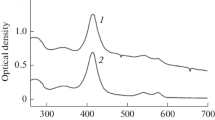Summary
A densimeter technique was used to measure the rate of exit of thiourea from erythrocytes of various species of mammals. The cells were first equilibrated with a 200mm thiourea solution in 1% NaCl. An aliquot of these cells was added to 1% NaCl containing 4.6–23.1mm thiourea. Facilitated diffusion was demonstrated in each case. Using exit times or initial rates, calculations of half-saturation constants (ϕ) inmm and maximum transport rates (K) in isotones per min were made by three different methods. The following values were obtained: human −ϕ=60, 42, 35;K=1.2, 2.9, 0.9; rabbit −ϕ=46, 33, 32;K=0.8, 2.1, 0.8; mouse −ϕ=46,40, 30;K=3.4, 8.5, 3.2; rat −ϕ=65, 42, 23;K=6.1, 15.3, 3.7; ox −ϕ=107, 63, 88;K=0.6, 1.4, 0.4; sheep −ϕ=56, 38, 56;K=0.9, 2.2, 0.6; and pig −ϕ=110, 64, 49;K=1.6, 3.6, 1.1.
Similar content being viewed by others
References
Baker, G.F., Widdas, W.F. 1973. The asymmetry of the facilitated transfer system for hexoses in human red cells and the simple kinetics of a two component model.J. Physiol. (London) 231:143
Barman, Th.E. 1969. Enzyme Handbook. Springer-Verlag, New York
Bowyer, F. 1954. Passage of glucose and glycerol across the red cell membrane.Nature (London) 174:355
Bowyer, F., Widdas, W.F. 1956. The facilitated transfer of glucose and related compounds across the erythrocyte membrane.Discuss. Faraday Soc. 21:251
Cainelli, S.R., Chui, A., McClure, J.D., Jr., Hunter, F.R. 1974. Facilitated diffusion in erythrocytes of mammals.Comp. Biochem. Physiol. 48A:815
Edwards, P.A.W. 1974. A test for non-specific diffusion steps in transport across cell membranes, and its application to red cell glucose transport.Biochim. Biophys. Acta 345:373
Ginsburg, H., Ram, D. 1975. Zero-trans and equilibrium-exchange efflux and infinite-trans uptake of galactose by human erythrocytes.Biochim. Biophys. Acta 382:369
Ginsburg, H., Stein, W.D. 1975. Zero-trans and infinite-cis uptake of golactose in human erythrocytes.Biochim. Biophys. Acta 382:353
Hunter, F.R. 1961. The effect ofn-butyl alcohol on the permeability of erythrocytes to non-electrolytes.J. Cell. Comp. Physiol. 58:203
Hunter, F.R. 1970a. Facilitated diffusion in human erythrocytes.Biochim. Biophys. Acta 211:216
Hunter, F.R. 1970b. Facilitated diffusion in pigeon erythrocytes.Am. J. Physiol. 218:1765
Hunter, F.R. 1976a. Facilitated diffusion in erythrocytes of additional mammals.Comp. Biochem. Physiol. 55A:323
Hunter, F.R. 1976b. Permeability of trout erythrocytes to nonelectrolytes.Biol. Bull. 151:322
Hunter, F.R., Fayad, R., Mayorga, I. 1976. Measurements of exit rates to distinguish between facilitated and simple diffusion.Am. J. Physiol. 231:332
Hunter, F.R., George, J., Ospina, B. 1965. Possible carriers in erythrocytes.J. Cell. Comp. Physiol. 65:299
Jacobs, M.H., Glassman, H.N., Parpart, A.K. 1935. Osmotic properties of the erythrocyte. VII. The temperature coefficients of certain hemolytic processes.J. Cell Comp. Physiol. 7:197
Jacobs, M.H., Parpart, A.K. 1937. The influence of certain alcohols on the permeability of the erythrocyte.Biol. Bull. 73:380
Kaplan, M.A., Hays, L., Hays, R.M. 1974. Evolution of a facilitated diffusion pathway for amides in the erythrocyte.Am. J. Physiol. 226:1327
Karlish, S.J.D., Lieb, W.R., Ram, D., Stein, W.D. 1972. Kinetic parameters of glucose efflux from human red blood cells under zero-trans condition.Biochim. Biophys. Acta 255:126
LeFevre, P.G. 1962. Rate and affinity in human red blood cell sugar transport.Am. J. Physiol. 203:286
LeFevre, P.G. 1975. The present state of the carrier hypothesis.Curr. Top. Membr. Transp. 7:109
Lieb, W.R., Stein, W.D. 1970. Quantitative prediction of a noncarrier model for glucose transport across the human red cell membrane.Biophys. J. 10:585
Macey, R.I., Farmer, R.E.L. 1970. Inhibition of water and solute permeability in human red cells.Biochim. Biophys. Acta 211:104
Mawe, R.C. 1956. The diffusion of glucose into the human red cell.J. Cell. Comp. Physiol. 47:177
Mawe, R.C., Hempling, H.G. 1965. The exchange of C14 glucose across the membrane of the human erythrocyte.J. Cell. Comp. Physiol. 66:95
Miller, D.M. 1965a. The kinetics of selective biological transport I. Determination of transport constants for sugar movements in human erythrocytes.Biophys. J. 5:407
Miller, D.M. 1965b. The kinetics of selective biological transport II. Equations for induced uphill transport of sugars in human erythrocytes.Biophys. J. 5:417
Miller, D.M. 1968b. The kinetics of selective biological transport III. Erythrocyte-monosaccharide transport data.Biophys. J. 8:1329
Miller, D.M. 1968b. The kinetics of selective biological transport IV. Assessment of three carrier systems using the erythrocyte-monosaccharide transport data.Biophys. J. 8:1339
Miller, D.M. 1969. Monosaccharide transport in human erythrocytes.In: Red Cell Membrane Structure and Function. G.A. Jamieson and T.J. Greenwalt, editors. p. 240. J.B. Lippincott, Philadelphia
Miller, D.M. 1971. The kinetics of selective biological transport V. Further data on the erythrocyte-monosaccharide transport system.Biophys. J. 11:915
Naftalin, R.J. 1970. A model for sugar transport across red cell membranes without carriers.Biochim. Biophys. Acta 211:65
Ospina, B., Hunter, F.R. 1966. Facilitated diffusion in mouse and rat erythrocytes.Nature (London) 211:851
Rabinowitz, L., Gunther, R.A. 1973. Urea transport in elasmobranch erythrocytes.Am. J. Physiol. 224:1109
Regen, D.M., Tarpley, H.L. 1974. Anomalous transport kinetics and the glucose carrier hypothesis.Biochim. Biophys. Acta 339:218
Sen, A.K., Widdas, W.F. 1962. Determination of the temperature and pH dependence of glucose transfer across the human erythrocyte membrane measured by glucose exit.J. Physiol. (London) 160:392
Widdas, W.F. 1955. Hexose permeability of foetal erythrocytes.J. Physiol. (London) 127:318
Author information
Authors and Affiliations
Rights and permissions
About this article
Cite this article
Hunter, F.R., Wong, C., Luis Carlos Gomezjuardo, D. et al. Comparative study of the thiourea carrier in erythrocytes. J. Membrain Biol. 31, 257–266 (1977). https://doi.org/10.1007/BF01869408
Received:
Revised:
Published:
Issue Date:
DOI: https://doi.org/10.1007/BF01869408




